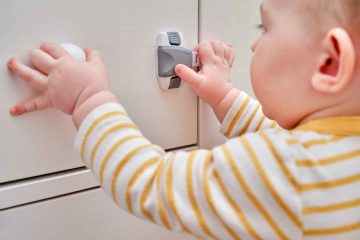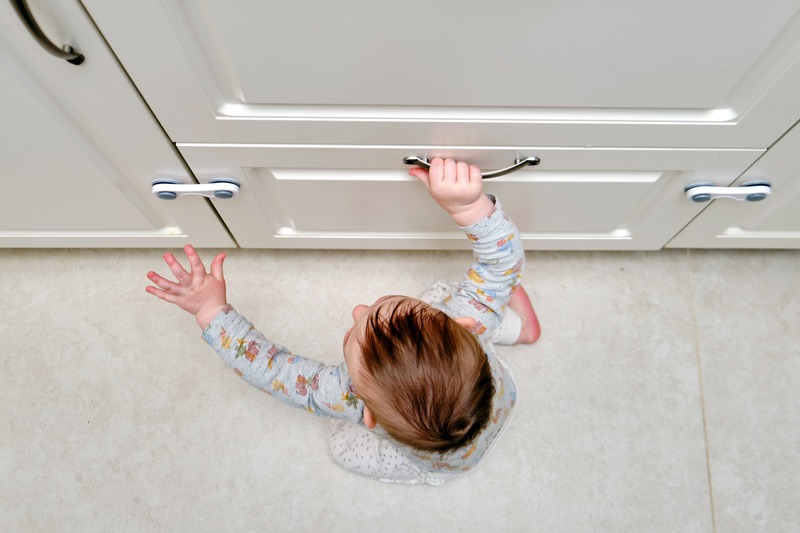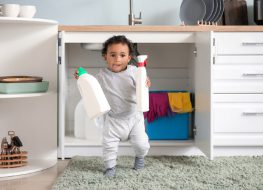
Is your baby in their “ninja phase?” By that, we mean crawling, rolling, scooting, and simply getting their hands on everything they come across. While seeing your once helpless child move on their own is a wonderful sight, it also poses serious risks. They are especially at risk to furniture like drawers and cabinets.
For that reason, you must start babyproofing your household. Don’t wait for your baby to have their little fingers pinched, fall from a climb, or break stuff from a drawer. Instead, start your childproof agenda with the following tips, from taking the dangers out to installing drawer locks!
3 Ways to Protect Your Child from Cabinetry Hazards
Prevention is always better than treatment, and babyproofing is no different. In fact, it is best if you start doing this even before your baby arrives. This way, you will have one less thing to be concerned about in the coming months.
If not, that’s fine! You just have to be prepared when they start moving on their own. That’s when they become interested in your items at home, such as cabinets. Toddlers would use it to climb onto something or to open and close it simultaneously.
Before they get into an accident, consider this quick, 3-step guide to keep your child safe from these objects!

#1: Eliminate the Dangers
First things first: take the dangerous objects out of sight! Any other solutions are useless if they are around and accessible. Your little one doesn’t know what’s dangerous and what’s not, so you have to remove these for them.
Some common examples are cutlery, lighters, cleaning products, pointed objects, electrical items, and medications. Be sure to store these things high so your toddler cannot reach them!
#2: Use Babyproofing Products
There are a bunch of tools available to keep your little one safe from cabinets and drawers. However, you don’t need all of them. This is why you should familiarize yourself with the different tools and find something to ensure your growing child’s safety.
First, count and measure your cabinets and drawers to make your product choices easier. Then, use this quick list of babyproofing products to pick your must-haves!
Drawer or Cabinet Locks
Let’s begin this list with the most common choice for childproofing cabinets or drawers: locks. There are different types of locks, such as magnetic latch locks, adjustable safety locks, and exterior, spring, and tab latches. Each has its benefits and limits, so it’s completely up to you.
For example, magnetic locks are strong and low-maintenance. Meanwhile, adjustable ones are easy to install but may leave a gap accessible to your child. Sliding locks are another option, but they are primarily designed for cabinets. Like adjustable locks, they’re easy to use and affordable but also leave gaps.
Tension Rods
Meanwhile, consider using tension rods if you have multiple drawers lined up in a row. They’re commonly used in curtains, but the right size will fit your drawer handles just fine. Insert a rod through the handles and secure the tip at the top level of the drawer.
They’re cheap, easy to install, and won’t damage your furniture. One drawback is that you must remove the rod whenever you access one of the drawers. Moreover, as your child ages, they will most likely figure out how to access it. So consider changing products when that time comes.
Furniture Anchors
Your child might attempt to climb on a dresser by stepping on opened drawers, which can cause a tip-over accident. In that case, consider installing furniture anchors on it. You can mount these anti-tip straps on a wall and hold the furniture to prevent it from falling.
Pull Cord Locks
Cord locks were one of the earliest methods of childproofing. As a result, they’re proven effective and are still relevant today. To install one, you have to put the cord around cabinet knobs or handles and tighten the adjuster to lock the drawer. Think of it as if you’re adjusting a backpack strap.
Velcro Strips
Do you not fancy the idea of drilling holes and figuring out complex lock systems? Stick-on Velcro strips would be a better choice for you. Simply place the strips on the frame inside a drawer or cabinet door, and you’re all set up! The Velcro will keep the furniture tightly closed (unless opened with great force). Note that the adhesive also wears out over time.
DIY Options
Lastly, you may explore inexpensive ways to secure your drawers from your little ninja. Consider DIY options like rubber bands, ropes, ribbons, zip ties, and foam bumpers. You can loop the ropes and ties around handles or slide the bumpers into corners to keep your baby safe from harm.
#3: Supervise Your Baby
Lastly, keep an eye on your child as much as you can. If you are not at home, get someone to supervise them while you’re away. Children are very creative, which is good but may lead them into heaps of trouble. So don’t rely on cabinet locks alone or be at ease when dangerous objects are out of reach. You never know what could happen, so watch your child at all times.
Locking the Door of Trouble
Witnessing the growth of your child is a wonderful experience. But, at the same time, you must keep your guard up because trouble is always possible. The more they get interested in something, the greater the risk. Worse, it might even lead to a major accident. No parent wants that, so babyproof your household as soon as possible.
Get rid of hazardous objects, install cabinet drawer locks or other childproofing products, and supervise your child at all times. All these can help ensure a safe and joyful place for you and your child!
Ashtonbee: Reliable Locks for a Babyproofed Household
Try Ashtonbee’s cabinet door locks for hassle-free installation! Our cabinet locks have a keyless design and take up minimal space on your furniture. Furthermore, they’re designed for smooth and textured furniture and come in 12 pieces. That’s a lot of cabinet doors that can be secured!
Check out our childproofing essentials now to know more about these products.


